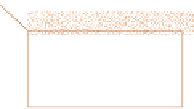Geoscience Reference
In-Depth Information
3
Relief and hydrology.
4
The length of time during which soil-forming proces-
ses have been active.
Vertical redistribution of soil materials
Leaching of ions in the soil solution
Movement of clay-sized particles
Upward movement of water by capillarity
Surface deposition of dust and aerosols
5
The ecosystem, including vegetation, fauna and the
effects of human activities.
Dokuchaiev, a famous nineteenth-century Russian soil
scientist, was the first to record the connection between
the genesis of soil profiles and these five controlling factors
(
Figure 18.3
).
Later an American soil scientist, Hans Jenny
(1941), expressed the relationship in his fundamental
equation of soil formation:
Mixing processes
Organisms (e.g. cambisols, chernozems)
Cultivation of agricultural soils
Creep processes on slopes
Frost heave (cryoturbation)
Swelling and shrinkage of clays (e.g. vertisols)
s
=
f
(
cl
,
p
,
r
,
t
,
o
)
where
s
= soil profile or property,
cl
= climate,
p
= parent
material,
r
= relief,
t
= time,
o
= organisms, including
humans. The importance of the work of Dokuchaiev,
Jenny and other pedologists is that soils are recognized as
'independent natural bodies', each with a distinct
succession of horizons reflecting the combined effects of
a particular combination of the five genetic factors. Over
time, soils were considered to evolve towards a condition
of equilibrium corresponding to a particular ecological
climax.
The effects of climate and soil formation operate
through precipitation and temperature. High rainfall
produces intense leaching and strongly acid soils. Lower
rainfall gives less marked leaching with the possibility of
calcium carbonate in soils over calcareous rocks and
deposits. Temperature affects the speed of biochemical
reactions in soil and the rate of evapotranspiration from
the soil surface. Thus low summer temperatures slow
down the rate at which rock minerals are weathered and
produce cold, raw soils (
Plate 18.3
).
The main properties of parent materials that influence
soil formation are the permeability, base content,
hardness, grain size and mineralogy of their weathering
are broad similarities, and full details can be found in
their published soil memoirs (Soil Survey of England and
Wales; Soil Survey of Scotland; National Soil Survey of
Ireland; Soil Conservation Service of the United States).
Internationally there are two commonly used soil classifi-
cation schemes: the
Soil Taxonomy
of the United States
Department of Agriculture (USDA) and the system used
by the United Nations Food and Agriculture Organization
and Educational Scientific and Cultural Organization
(FAO-UNESCO). The FAO system is the one used in this
book and details are given later in this chapter.
(PEDOGENIC FACTORS)
The nature of the soil profile at any particular place on
Earth depends upon five main pedogenic factors. These
are:
1
The past and present climate.
2
The physical and chemical characteristics of the parent
material.
Climate
Topography
Human
activities
SOIL
PROCESSES
Flora and fauna
Figure 18.3
Controlling factors in soil
formation.
Soil
parent material
Soil development









































































